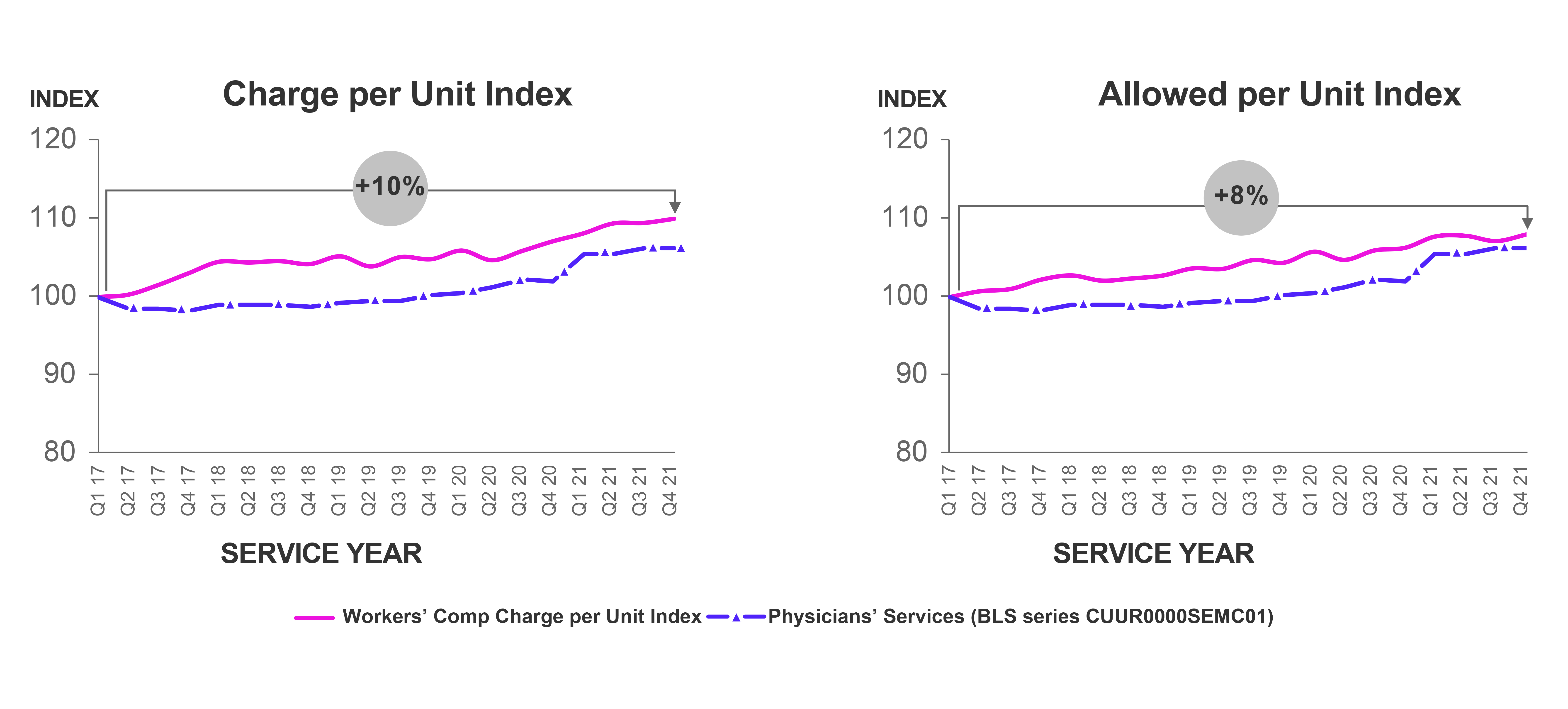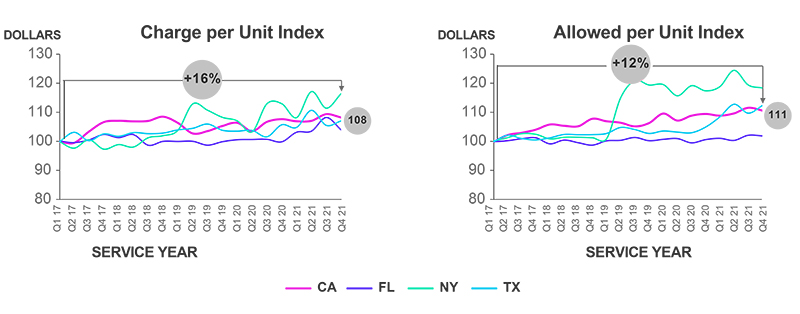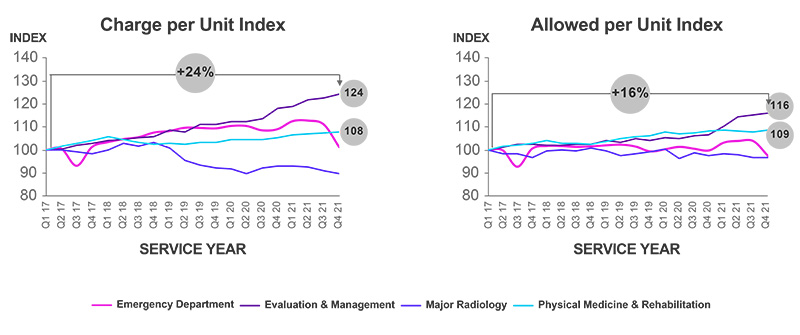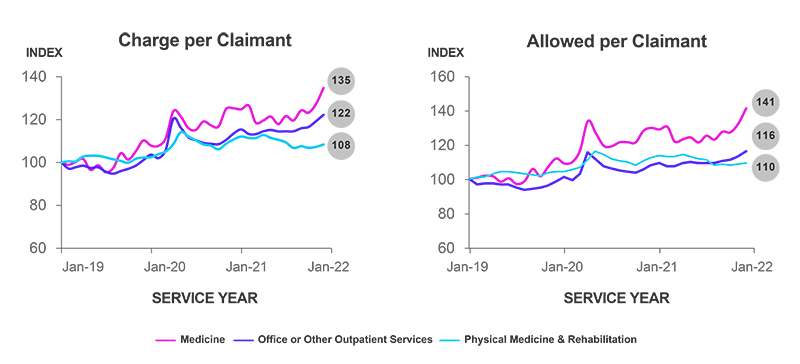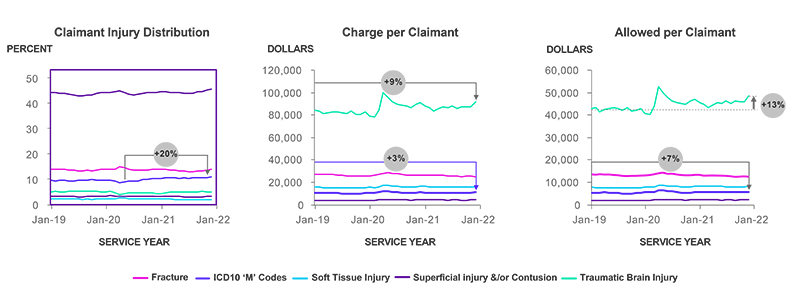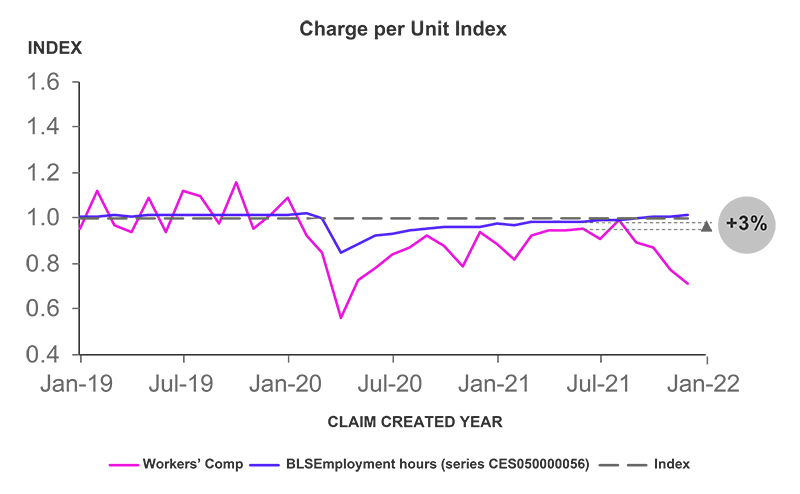How Medical Inflation is Affecting Workers’ Compensation Claims
The rate of inflation in United States rose by 7.9% in February 2022 compared to February 2021, the largest spike in the past 40 years. According to McKinsey, it is only a matter of time until medical inflation catches up. To help understand how medical inflation is affecting the workers’ compensation industry today, Enlyte analyzed its medical bill review data. Below, we’ve outlined our key findings and trends to watch as this pattern continues. This data covers Q1 2017 through the end of Q4 2021.
Medical Inflation at the National Level
The graphs above show workers’ compensation charge and allowed per unit, respectively, at the national level.
From Q1 2017 to the end of Q4 2021, physician charge per unit has increased 10% while allowed per unit increased by 8%. In comparison, the Bureau of Labor Statistics Physician Services Consumer Price Index increased 6%.
Medical Inflation at the State Level
The graphs above demonstrate workers’ compensation charged and allowed per unit, respectively, in New York, Florida, California and Texas.
To dive deeper into how medical inflation has varied, we’ve highlighted a few key states to show how inflation has affected a few high-volume jurisdictions.
- Since Q1 2017, New York demonstrated a 16% increase in charge per unit and 12% increase in allowed per unit.
- Despite Florida’s 10% increase in charge per unit in 2021, allowed per unit only increased 2%.
- Both California and Texas experienced an 8% increase in charge per unit and an 11% increase in allowed per unit.
Medical Inflation by Service Group
The charts above demonstrate workers’ compensation charged and allowed per unit, respectively, broken down by service group including evaluation and management, physical medicine and rehabilitation and emergency department services.
Another way to view medical inflation trends is to break down charges by service groups. Here were some key findings:
- Since Q1 2017, the charge per unit for evaluation and management services increased 24%, while allowed per unit increased 16%.
- Since Q1 2017, the charge per unit for physical medicine and rehabilitation services increased 8%, while allowed per unit increased 9%.
- Between Q1 2017 and Q3 2021, the charge per unit for emergency department services increased 10%, while allowed per has remained flat.
Medical Severity by Service Group
The charts above demonstrate charged and allowed per claimant for some of the most frequent service groups.
In addition, Enlyte identified a few other service groups that are driving the increase of medical severity in workers’ compensation.
- The charge per claim index for three of the most encountered service groups reveals a 35% increase in medicine services, a 22% increase in office and other outpatient services and an 8% increase in physical medicine and rehabilitation.
- The allowed per claim index for three of the most encountered service groups demonstrates a 41% increase in medicine services, a 16% increase in office and other outpatient services and an 10% increase in physical medicine and rehabilitation.
Medical Severity by Injury Classification
The charts above demonstrate claimant injury distribution as well as charge and allowed per claimant for specific injury classifications.
Enlyte’s bill review data shows medical severity increases in a few specific injury classifications:
- Except for the 20% increase in claimants classified with ICD10 ‘M’ injuries, or diseases of the musculoskeletal system, the distribution of claimant injuries has remained relatively steady since January 2019.
- Charge per claim has increased 9% and allowed per claim has increased 13% for traumatic brain injury claims since January 2019.
- Claims with diseases of the musculoskeletal system have seen charge and allowed severity increase 3% and 7%, respectively.
Claim Frequency
The chart above demonstrates workers’ compensation claim frequency compared to the Bureau of Labor Statistics employment hours.
Claim frequency is another factor affecting the industry today. As a result of the pandemic, working habits have changed, with one marked downturn in the number of hours worked as reported by the Bureau of Labor Statistics, leading to a decrease in claim frequency. While the number of hours worked have returned to pre-pandemic levels, claim frequency remains approximately 3% lower than pre-pandemic which you can see on the graph.
About Our Data
This report is generated based on Enlyte’s workers’ compensation Medical Price Index, which compiles its bill review data. The data we analyzed for this report is from Q1 2017 through the end of Q4 2021.



